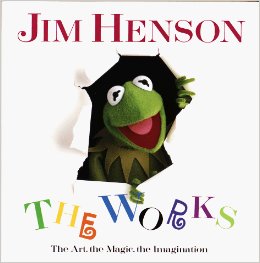 Sometimes even I’m amazed at what’s in the Estate Library. I found this book unexpectedly this week and though it was published in 1993, I’ve never seen it ’til now.
Sometimes even I’m amazed at what’s in the Estate Library. I found this book unexpectedly this week and though it was published in 1993, I’ve never seen it ’til now.
This is another authorised project by the Jim Henson Company, making it akin to Imagination Illustrated which I reviewed here. It’s even copyrighted by Jim Henson Productions! Unlike that book, it actually covers the life of Jim from birth, in a nifty little laid-in booklet. That’s after not one but three introductions by Harry Belafonte, Frank Oz, and Candice Bergen. Belafonte and Bergen were just two of the many, many actors who appeared on The Muppet Show.
It’s also physically a much bigger book that, while it obviously dwells somewhat on Jim, is smart enough to include the myriad other folks that made the Jim Henson Company the creative and financial success it is to this day. And it’s much more of a book about the making of muppets and other creatures than Imagination Illustrated was; it’s a history focused on what Jim and his associates created rather than just Jim himself did.
What to know how The Dark Crystal came to be, and see the design sketches by Jim? Interested in what the puppets looked like for his first show, Sam and Friends? That’s here along with how the show came to be. Or how the amazing feats of puppetry were done in The Muppet Movie? That’s obviously here in loving detail.
For me, it was the more obscure undertakings lost to history in many cases that I found the most fascinating. Did you know Rowlf, the dog character who plays the piano on The Muppet Show was a co-host of sorts on The Jimmy Dean Show? You might have had Jimmy Dean’s sausages, which are sold to this day in American supermarkets. And Rowlf would be featured in a series of short films at IBM for their salesmen. (I’m not being sexist there this was the Sixties and IMD had no sales staff.) Or that the muppets appeared on Saturday Night Live for a season?
(An aside. If you look at pages 148 and 149, you’ll see that illustrations crossing both pages get partially lost in the gutter. This happens a numbers of times in this book. Both the designer of the book and the company that did the printing screwed up royally.)
There’s far too much good stuff to detail here, so I’ll just mention that it’s as much about the people and how they made the productions work as it is about the productions themselves. See page 115 for a photo of some of the eyes designed by the Jim Henson Company staff, or page 65, which shows some of the drawers at the Jim Henson Company that held the bits needed to create these creatures.
It’s quite simply the best book I’ve seen on Jim Henson and what he created. I looked for an updated edition but couldn’t find one, which is a pity as programs like Farscape are not here.
Highly recommended for anyone interested in puppets in general or the work of the Jim Henson Company in particular.
(Random House, 1993)
